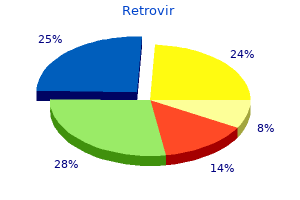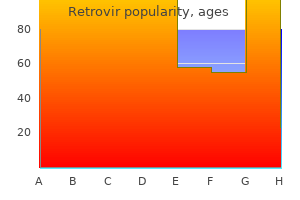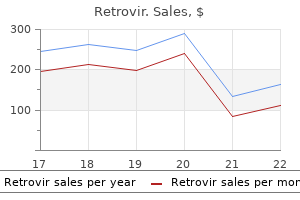Retrovir

"Cheap 100 mg retrovir amex, symptoms colon cancer".
E. Hernando, M.B.A., M.D.
Co-Director, Ponce School of Medicine
Once cultures and sensitivities return medications in canada retrovir 100mg cheap, long-term culture-directed antibiotics can be used (Table 2 medications without a script purchase 100 mg retrovir with visa. Nephrotoxicity in diabetics given aminoglycosides is a concern medicine 4h2 300mg retrovir amex, so ceftazidime has been given as monotherapy symptoms 3 days past ovulation retrovir 300 mg generic. Fluoroquinolones, primarily ciprofloxacin, can be given orally with excellent cure rates, but again, concerns of drug resistance have arisen. As long as resistance does not emerge, oral fluoroquinolones can be used, and average 148 Handbook of OtolaryngologyHead and Neck Surgery Table 2. The endpoint of therapy is individualized with gallium scanning, and treatment courses have been documented to run several months. Surgical Surgical management is limited to initial canal dйbridement and myringotomy tube placement if needed. N Outcome and Follow-Up With proper diagnosis and treatment, cure rates are over 80%. Thresholds represent the softest sound audible at least 50% of the time measured in decibels. Immittance testing assesses the status of the middle ear and acoustic reflex pathways. Approximately 314 in 1000 people over age 65 have hearing loss, as do 40 to 50% of people over age 75. N Clinical Signs and Symptoms Persons with hearing loss frequently report difficulty hearing in background noise. They often need the television volume louder than is comfortable for others and ask for things to be repeated. Differential Diagnosis Results of audiometric testing are typically plotted on an audiogram. An audiogram is a graph with frequency (in Hz) plotted on the x axis and intensity (in decibels) plotted on the y axis. It is necessary to employ masking (a static type of noise) in certain situations to prevent the nontest ear from detecting the test signal. Red flags should prompt referral to 150 Handbook of OtolaryngologyHead and Neck Surgery. Otologic disease may be categorized as conductive hearing loss, sensorineural loss, or mixed hearing loss. In a conductive loss, there is an airbone gap on the audiogram, with better bone-conduction thresholds, with appropriate masking. The loss may be due to dysfunction involving the external canal, tympanic membrane, or ossicular chain, or middle ear fluid. A poor word-recognition score, especially out of proportion to pure tone thresholds, suggests possible retrocochlear pathology, such as an acoustic tumor. Patterns of sensorineural loss may be suggestive of certain etiologies, taken together with clinical history and exam. For example, acoustic trauma (noise-induced loss) often results in a loss centered around 4 kHz with recovery at higher frequency, i. This indicates immobility of the tympanic membrane, which may be due to fluid in the middle ear or tympanic atelectasis. The Jerger system is commonly used to classify tympanometric results: G Type A Normal G Pressure peak 100 to 100 daPa G Immittance 0. G Large ear canal volume suggests patent pressure equalization tube or perforated eardrum. N Evaluation Tuning Fork Tests the goal of these tests, including the Weber test. Weber Test the Weber test will lateralize to the ear with conductive loss, if sensory hearing is equal (see. It usually takes about a 30-dB conductive loss to flip the tuning fork response, to bone conduction greater than air. Insert earphones placed in the ear canal are the transducer of choice in assessing air-conduction thresholds due to infection control, increased interaural attenuation, and prevention of collapsed ear canals. Conventional behavioral audiometry is conducted by having a person respond to pure tones. Word recognition is assessed by repeating phonetically balanced lists of monosyllabic words at suprathreshold intensity.

As little as 4 h of acute hyperglycemia enhances platelet activation in patients with type 2 diabetes (51) medicine emoji generic 300 mg retrovir. In this crossover symptoms leukemia buy generic retrovir 100 mg online, double-blind study medicine to stop runny nose discount retrovir 100mg free shipping, 12 patients were subjected to hyperglycemic (250 mg/dl medications like xanax 300mg retrovir overnight delivery, 13. Hyperglycemia also caused increased plasma von Willebrand factor antigen, von Willebrand factor activity, and urinary 11dehydro-thromboxane B2 (a measure of thromboxane A 2 production). If hyperglycemia-induced platelet hyperreactivity is particularly evident with highshear stress conditions, as suggested in the above studies, this finding may explain the increased thrombotic events commonly seen in hospitalized patients with diabetes. Hyperglycemia and inflammation the connection between acute hyperglycemia and vascular changes likely involves inflammatory changes. Elevations of these various inflammatory factors have been linked to detrimental vascular effects. Hyperglycemia and endothelial cell dysfunction One proposed link between hyperglycemia and poor cardiovascular outcomes is the effect of acute hyperglycemia on the vascular endothelium. In addition to serving as a barrier between blood and tissues, vascular endothelial cells play a critical role in overall homeostasis. In the healthy state, the vascular endothelium maintains the vasculature in a quiescent, relaxant, antithrombotic, antioxidant, and antiadhesive state (rev. During illness the vascular endothelium is subject to dysregulation, dysfunction, insufficiency, and failure (76). Endothelial cell dysfunction is linked to increased cellular adhesion, perturbed angiogenesis, increased cell permeability, inflammation, and thrombosis. Commonly, endothelial function is evaluated by measuring endothelial-dependent vasodilatation, looking most often at the brachial artery. Human in vivo studies utilizing this parameter confirm that acute hyperglycemia to the levels commonly seen in the hospital setting (142300 mg/dl or 7. Only one study failed to show evidence of endothelial cell dysfunction induced by short-term hyperglycemia (83). The degree of endothelial cell dysfunction after an oral glucose challenge was positively associated with the peak glucose level, ranging from 100 to 300 mg/dl (5. Hyperglycemia may directly alter endothelial cell function by promoting chemical inactivation of nitric oxide (84). Despite compelling experimental data, studies examining a possible association among hyperglycemia, endothelial function, and outcomes have not to date been done in hospitalized patients. Hyperglycemia and the brain Acute hyperglycemia is associated with enhanced neuronal damage following induced brain ischemia (8598). Models differ according to transient versus permanent ischemia as well as global versus localized ischemia. There is some indication from animal studies that irreversible ischemia or end arterial ischemia is not affected by hyperglycemia (87,99,100). The major portion of the brain that is sensitive to injury from hyperglycemia is the ischemic penumbra. During evolution of the stroke, the ischemic penumbra may evolve into infarcted tissue or may recover as viable tissue (87,99,101,102). One of the primary mechanistic links between hyperglycemia and enhanced cerebral ischemic damage appears to be increased tissue acidosis and lactate levels associated with elevated glucose concentrations. Lactate has been associated with damage to neurons, astrocytes, and endothelial cells (104). More recently, the same investigators used this method to demonstrate a positive correlation between glucose elevations and lactate production (110). Through this mechanism, hyperglycemia appears to cause hypoperfused at-risk tissue to progress to infarction. Animal studies have shown additional association of hyperglycemia with various acute consequences that likely serve as intermediaries of adverse outcomes. For example, hyperglycemia causes accumulation of extracellular glutamate in the neocortex. A unique hippocampal cell culture model of "in vitro ischemia" demonstrated a similar relationship between hyperglycemia, glutamate activity, and increased intracellular calcium with enhanced cell death (98). Many of the same factors noted earlier, linking hyperglycemia to cardiovas556 cular event outcomes, likely contribute to acute cerebrovascular outcomes.

The joint diabetesrenal clinic in clinical practice: 10 years of data from a district general hospital symptoms jaw cancer generic retrovir 300 mg without a prescription. Association of type 1 diabetes mellitus counterfeit medications 60 minutes 100 mg retrovir fast delivery, maternal vascular disease and complications of pregnancy medicine in the civil war generic retrovir 100 mg with mastercard. The association of intrauterine growth abnormalities in women with type 1 diabetes mellitus complicated by vasculopathy medicine dropper discount 300 mg retrovir visa. Improved pregnancy outcome in type 1 diabetic women with microalbuminuria or diabetic nephropathy: effect of intensified antihypertensive therapy? From the clinical point of view, it is important to note that, based on these pathogenetic mechanisms, therapeutic approaches could be derived, some of which are currently being evaluated in clinical trials. Analgesic combination therapy may be useful, and potential drug interactions have to be considered given the frequent polypharmacy in people with diabetes. Classification and epidemiology Diabetic neuropathy has been defined as a demonstrable disorder, either clinically evident or subclinical, that occurs in the setting of diabetes without other causes for peripheral neuropathy. It includes manifestations in the somatic and/or autonomic parts of the peripheral nervous system [1] which are being classified along clinical criteria; however, because of the variety of the clinical syndromes with possible overlaps there is no universally accepted classification. The most widely used classification of diabetic neuropathy proposed by Thomas [2] has subsequently been modified [3]. This proposal differentiates between rapidly reversible, persistent symmetric polyneuropathies and focal or multifocal neuropathies (Table 38. There is emerging evidence to suggest that intermediate hyperglycemia is associated Textbook of Diabetes, 4th edition. Pain is a subjective symptom of major clinical importance as it is often this complaint that motivates patients to seek health 615 Part 7 Microvascular Complications in Diabetes Table 38. While 77% of the patients reported persistent pain over 5 years, 23% were pain-free over at least 1 year [11]. Thus, neuropathic pain persists in the majority of patients with diabetes over periods of several years. As well as the high prevalence of painful neuropathy among people with diabetes and intermediate hyperglycemia described previously, subjects with macrovascular disease appear to be particularly prone to neuropathic pain [14]. Its onset is insidious and, in the absence of intervention, the course is chronic and progressive. It seems that the longer axons to the lower limbs are more vulnerable to the nerve lesions induced by diabetes (length-related distribution). The neuropathic process then extends proximally up the limbs and later it may also affect the anterior abdominal wall and then spread laterally around the trunk. Occasionally, the upper limbs are involved with the fingertips being affected first ("glove and stocking" distribution; Figure 38. Variants including painful small-fiber or pseudosyringomyelic syndromes and an atactic syndrome (diabetic pseudotabes) have been described. Small-fiber unmyelinated (C) and thinly myelinated (A) fibers as well as large-fiber myelinated (A, A) neurons are typically involved. It is as yet uncertain whether the various fiber type damage develops following a regular sequence, with small fibers being affected first, followed by larger fibers, or whether the small-fiber or large-fiber involvement reflects either side of a continuous spectrum of fiber damage. Nevertheless, there is evidence suggesting that small-fiber neuropathy may occur early, often presenting with pain and hyperalgesia before sensory deficits or nerve conduction slowing can be detected [2]. The reduction or loss of small fiber-mediated sensation results in loss of pain sensation (heat pain, pinprick) and temperature perception to cold (A) and warm (C) stimuli. Large-fiber involvement leads to nerve conduction slowing and reduction or loss of touch, pressure, two-point discrimination and vibration sensation which may lead to sensory ataxia (atactic gait) in severe cases. Sensory fiber involvement causes "positive" sensory symptoms such as paresthesia, dysesthesia and pain, as well as "negative" symptoms such as reduced sensation. Persistent or episodic pain that typically worsens at night and improves during walking is localized predominantly in the feet. The pain is often described as a deep-seated aching but there may 616 Diabetic Peripheral Neuropathy Chapter 38 Time Time Figure 38. The pain was most often described by the patients as "burning/hot," "electric," "sharp," "achy" and "tingling" and was worse at night time and when tired or stressed [10]. The symptoms may be accompanied by sensory loss, but patients with severe pain may have few clinical signs. Pain may persist over several years [16] causing considerable disability and impaired quality of life in some patients [10], whereas it remits partially or completely in others [17,18], despite further deterioration in small-fiber function [18].
The role of low-fat diets in body weight control: a meta-analysis of ad libitum dietary intervention studies symptoms of hiv generic 100 mg retrovir amex. Effect of a high-protein medicine 0031 generic 300 mg retrovir, low-carbohydrate diet on blood glucose control in people with type 2 diabetes useless id symptoms discount retrovir 100mg with visa. Effect of energy restriction treatment in statistics cheap retrovir 300mg fast delivery, weight loss, and diet composition on plasma lipids and glucose in patients with type 2 diabetes. Long-term improvement in insulin sensitivity by changing lifestyles of people with impaired glucose tolerance: 4-year results from the Finnish Diabetes Prevention Study. Non-caloric sweeteners are safe, when daily allowances are followed · Alcoholic beverages should only be taken in moderation 12 small glasses of wine or beer are tolerable when no specific contraindication must be considered; however, consider the caloric amounts and also the risk of hypoglycemia when consumed without food · Special dietetic foods for persons with diabetes are unnecessary. Persons with diabetes can enjoy usual foods · Meals, snacks and food choices should match individual therapeutic needs, preferences and culture References 1 Mann J, De Leeuw I, Hermansen K, Karamanos B, Karlstrцm B, Katsilambros N, et al. Effects of varying carbohydrate content of diet in patients with non-insulin-dependent diabetes mellitus. Prevalence of chronic complications, metabolic control and nutritional intake in type 1 diabetes: comparison between different European regions. Nutritional habits of subjects with type 2 diabetes mellitus in the Mediterranean Basin: comparison with the nondiabetic population and the dietary recommendations. Nutritional habits in the Mediterranean Basin: the macronutrient composition of diet and its relation with the traditional Mediterranean diet. Carbohydrates and increases in obesity: does the type of carbohydrate make a difference? Nutrient intakes as predictors of body weight in European people with type 1 diabetes. Long-term effects of ad libitum low-fat, high-carbohydrate diets on body weight and serum lipids in overweight subjects with metabolic syndrome. Dietary carbohydrate (amount and type) in the prevention and management of diabetes. Towards understanding of glycaemic index and glycaemic load in habitual diet: associations with measures of glycaemia in the Insulin Resistance Atherosclerosis Study. Dietary glycemic index and glycemic load, carbohydrate and fiber intake, and measures of insulin sensitivity, secretion, and adiposity in the Insulin Resistance Atherosclerosis Study. Improved plasma glucose control, whole-body glucose utilization, and lipid profile on a low-glycemic index diet in type 2 diabetic men: a randomized controlled trial. Relation of fibre intake to HbA1c and the prevalence of severe ketoacidosis and severe hypoglycaemia. Long-term dietary treatment with increased amounts of fiberrich low glycemic index natural foods improves blood glucose control and reduces the number of hypoglycaemic events in type 1 diabetic patients. Fiber intake, serum cholesterol levels and cardiovascular disease in European individuals with type 1 diabetes. Glycemic index in the diet of European outpatients with type 1 diabetes: relations to HbA1c and serum lipids. Improved glycemic control and lipid profile and normalized fibrinolytic activity on a low glycemic index diet in type 2 diabetes mellitus patients. The effect of flexible low glycemic index dietary advice versus measured carbohydrate exchange diets on glycemic control in children with type 1 diabetes. Low-glycemic index diets in the management of diabetes: a meta-analysis of randomized controlled trials. Evidence-based nutritional recommendations for the treatment and prevention of diabetes and related complications: a European perspective (letter). The use of no-concentrated-sweets diet in the management of type 2 diabetes in nursing homes. Training in flexible, intensive insulin management to enable dietary freedom in people with type 1 diabetes. Effects of meal carbohydrate content on insulin requirements in type 1 diabetic patients treated intensively with the basal-bolus (Ultralenteregular) insulin regimen. Evidence-based nutrition principles and recommendations for the treatment and prevention of diabetes and related complications: technical review.

